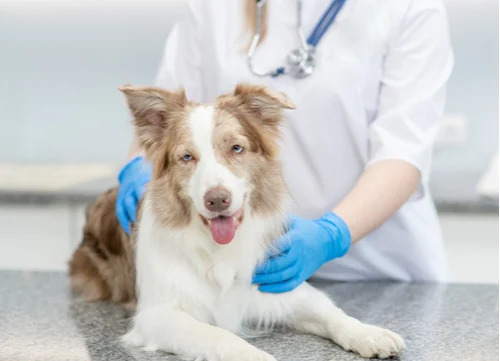Can Dogs Have Xylitol Poisoning? Is it safe to give them food or ingredients with them? Let’s dive deep into the details.
Can Dogs Have Xylitol Poisoning? Can it be a thing of worry? What are the areas that you need to take care of? Let’s have a look.
What is Xylitol?

Xylitol is a sugar substitute that’s toxic to dogs. It’s commonly found in foods and dental products and can cause hypoglycemia and other serious health issues if ingested. Xylitol also has a low glycemic index, meaning it does not cause a rapid rise in blood sugar levels.
Read here about Can Dogs Have Alcohol Poisoning?
What is Xylitol Poisoning?
Xylitol poisoning is a serious condition that can occur when dogs ingest xylitol, a sugar substitute commonly used in sugar-free chewing gum, candy, baked goods, and other products.
Xylitol is safe for humans to consume, but it can cause a rapid insulin release in dogs, leading to a dangerous drop in blood sugar levels, seizures, liver failure, and even death in severe cases.
Where is Xylitol Found?
Xylitol can be found in a variety of foods and products, including:
- Sugar-free gum: Xylitol is a common ingredient in sugar-free chewing gum.
- Candy: Xylitol is also used as a sweetener in sugar-free candy and mints.
- Baked goods: Xylitol is sometimes used in baking as a sugar substitute in recipes for cakes, cookies, and other desserts.
- Peanut butter: Some brands of peanut butter may contain xylitol as a sweetener.
- Dental products: Xylitol is commonly found in toothpaste, mouthwash, and other dental products.
- Other products: Xylitol is also used as a sweetener in some beverages, vitamins, and supplements.
Can Dogs Have Xylitol Poisoning?

So, Can Dogs Have Xylitol Poisoning? Xylitol is toxic to dogs because it can cause a rapid release of insulin from the pancreas, leading to a dangerous drop in blood sugar levels (hypoglycemia). In dogs, xylitol is absorbed rapidly into the bloodstream, causing a sudden release of insulin that can lead to hypoglycemia within 10 to 60 minutes of ingestion.
While xylitol is safe for humans, dogs process it differently. Dogs do not produce as much insulin as humans, and their liver is less effective at removing xylitol from their bloodstream. This can lead to a buildup of xylitol in their system, causing a dangerous drop in blood sugar levels.
In addition to hypoglycemia, xylitol ingestion can also cause liver damage in dogs. Xylitol can cause an overproduction of insulin, which can lead to liver damage and failure.
How Much Xylitol is Poisonous to a Dog?
The amount of xylitol that can be poisonous to a dog depends on the size of the dog and the amount of xylitol ingested. As little as 50 milligrams (mg) of xylitol per kilogram of body weight can cause hypoglycemia in dogs, while as little as 100 mg per kilogram of body weight can cause liver failure.
To give you an idea of how little xylitol this is, a typical piece of sugar-free gum may contain 0.22 to 1.0 grams (220-1000 mg) of xylitol, which is enough to cause hypoglycemia in a 10-pound dog.
Signs of Xylitol Poisoning in Dogs
- Vomiting and loss of appetite
- Lethargy and weakness
- Loss of coordination and stumbling
- Seizures
- Coma
- Hypoglycemia (low blood sugar)
- Jaundice (yellowing of the skin and eyes)
- Collapse and difficulty in breathing
Read here about Can Dogs Eat Vienna Sausages | Are Vienna Sausages Safe for Dogs?
How is Xylitol Poisoning Treated?

The treatment for xylitol poisoning in dogs depends on the severity of the poisoning and the time elapsed since ingestion. Here are some common treatment methods:
- Inducing vomiting: If the dog has recently ingested xylitol (within 30 minutes to an hour), inducing vomiting can help remove the toxin from the body.
- Administration of activated charcoal: Can treat xylitol toxicity in dogs by absorbing the xylitol and preventing it from entering the bloodstream.
- Intravenous fluids: The administration of fluids can help stabilize the dog’s blood sugar levels and support liver function.
- Glucose supplementation: In cases of hypoglycemia, glucose can be administered either orally or intravenously to help raise blood sugar levels.
- Liver support: In severe cases of xylitol poisoning, liver damage can occur.
- Hospitalization: If a dog’s condition due to xylitol ingestion is severe, hospitalization may be required for close monitoring and treatment.
Recovery and Management of Xylitol Poisoning in Dogs
In general, dogs that receive prompt and appropriate treatment have a good chance of recovery.
Treatment for xylitol poisoning may include inducing vomiting to remove any remaining xylitol from the stomach, administering activated charcoal to prevent further absorption of xylitol, and providing IV fluids and glucose support to stabilize the dog’s blood sugar levels. Depending on the severity of the poisoning, hospitalization and monitoring may also be necessary.
Foods that Can Lead to Xylitol Poisoning in Dogs
- Sugar-free gum: Many brands of sugar-free gum contain xylitol as a sugar substitute.
- Candy and baked goods: Xylitol is often used in sugar-free candy and baked goods.
- Peanut butter and other nut butter: Some brands of peanut butter and other nut butter may contain xylitol as a sweetener.
- Sugar-free yogurt and ice cream: Some brands of sugar-free yogurt and ice cream may contain xylitol.
- Sugar-free or reduced-calorie drinks: Some brands of sugar-free or reduced-calorie drinks, such as diet soda, may contain xylitol.
- Vitamin and supplement products: Some vitamin and supplement products may contain xylitol.
Read out here about Can Dogs Eat Raisins | Are Currants Good for Dogs?
Quick Takeaways
So, Can Dogs Have Xylitol Poisoning? Xylitol is a sugar substitute that is safe for humans but toxic to dogs. Xylitol poisoning can cause symptoms such as vomiting, loss of coordination, seizures, and liver failure.
